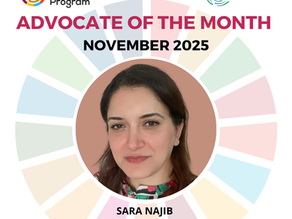Implementing SDG 11 in lesson plans
- SDSN Youth

- Nov 9, 2021
- 3 min read
Written by Lissette Pino, Global Schools Advocate in Ecuador

What is the major concern of most teachers about school curriculum? As an educator, I can say that time constraints are definitely the main burden for every teacher. This is not only due to the pressure of school policies but also due to the idea that children must acquire as much subject knowledge as they can during their school years.
However, as teachers, we must ask ourselves: what will my students need to know in twenty years? Learning by rote memorization will mean nothing when facing real-world issues such as poverty, climate change, and more. Therefore, as educators, we must encourage our students to develop the competencies needed to become knowledgeable citizens that will tackle sustainability problems and to make a positive change in communities.
While this is an easy statement to make, in practice, teachers might feel as if their hands are tied due to the concerns of completing the national curriculum. Therefore, I will give you one example of how I connected my school curriculum with SDG 11: Sustainable Cities and Communities.
Subject: English as a Foreign Language
Grade: Grade 9
Original curriculum objectives
To identify and apply extreme adjectives to describe cities.
To prepare a presentation using a presentation plan.
Curriculum objectives linked with SDG 11
To discuss what makes a city sustainable.
To identify and apply extreme adjectives to describe sustainable cities.
To research and evaluate ways to make Guayaquil more sustainable.
To prepare a presentation following a presentation plan about my previous findings.
As you can see, the lesson plan objectives that included the analysis of SDG 11 developed more competencies than the original one. Moreover, as a teacher, I can implement more teaching strategies such as cooperative learning, inquiry-based instruction, and youth sensitization on SDGs.
During the lesson plan, my students went through different stages of sensitization that allowed them to prepare a well-structured presentation. At the beginning of the lesson, they brainstormed ideas around the question: "What would a perfect city look like?" Most students agreed that a perfect city is clean, secure, and inclusive. Afterward, they compared their own city, Guayaquil, with the descriptions mentioned during the brainstorming session.
Then students watched a video about the meaning of sustainability and how to be financially, socially, and environmentally sustainable. In order to teach the language features of the class, my students played Kahoot and jotted down the extreme adjectives they could find in the game. Next, they watched a video about the most sustainable cities in the world and applied the previous language to describe how those cities have achieved sustainability and how those solutions are related to SDG 11 Targets.

To conclude, students were tasked to prepare a presentation around the question: how can we make Guayaquil more sustainable? They were requested to analyze the following points:
1. To what extent is your city sustainable?
2. What can be done to make your city more sustainable?
3. How are your solutions related to SDG 11 targets?
I could spend hours describing the positive results that this activity had in increasing my student's knowledge about the subject and the development of their competencies. However, I prefer to show you an example of their work:
Click here to watch a video of one of my 9th grade students: https://www.youtube.com/watch?v=HL1dJHAa9Lc

"What I learned through this class is that we need to stick together as a community to achieve positive things, such as a sustainable city. We also need to learn about sustainable development goals to understand the importance of taking care of our world and our responsibility [that comes] with it."
Ana Valeria Miño - Grade 9
Connecting SDGs in your curriculum is valuable. Giving students the tools to become agents of change in their communities empowers them to develop competencies that can be used in real-life contexts. Moreover, students see more purpose in the subject, which leads to better possibilities to acquire lifelong learning.
If you want to access this lesson plan with all the accompanying resources, do not hesitate to contact me: lissette.pino@hotmail.com
Embrace Education for Sustainable Development and be amazed by the results!
Written by Lissette Pino, Global Schools Advocate in Ecuador

















Comments